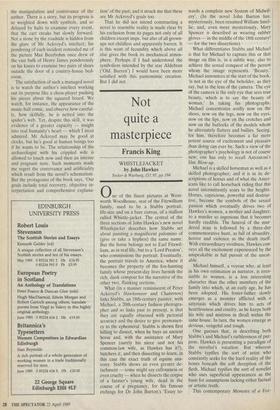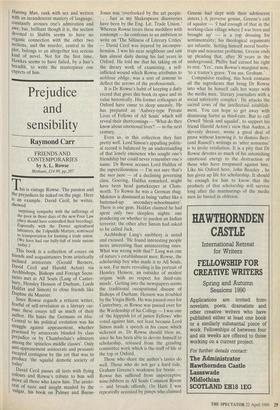Not quite a masterpiece
Francis King
WHISTLEJACKET by John Hawkes
Secker & Warburg, £11.95, pp.I94
One of the finest pictures at Went- worth Woodhouse, seat of the Fitzwilliam family, used to be a Stubbs portrait, life-size and on a bare canvas, of a stallion called Whistle-jacket. The central of the three sections of John Hawkes's new novel Whistiejacket describes how Stubbs set about painting a magnificent palomino of (give or take a hyphen) the same name. But the horse belongs not to Earl Fitzwil- liam, as in real life, but to a 'Lord Preston', who commissions the portrait. Eventually, the portrait travels to America, where it becomes the property of the fox-hunting family whose present-day lives furnish the rich, dank compost for the narrative of the other two, flanking sections.
What (in a manner reminiscent.of Peter Ackroyd's Hawksmoor and Chatterton) links Stubbs, an 18th-century painter, with Michael, a 20th-century fashion photogra- pher and so links past to present, is that they are equally obsessed with pictorial accuracy and the desire to give permanen- cy to the ephemeral. Stubbs is shown first killing to dissect, when he buys an ancient horse and, with the assistance of Mary Spencer (surely his niece and not his common-law wife, as Hawkes has it?), butchers it; and then dissecting to learn, in this case the exact truth of equine ana- tomy. Stubbs shows an even greater de- tachment — some might say callousness or even cruelty — when he dissects the corpse of a farmer's young wife, dead in the course of a pregnancy, for his famous etchings for Dr John Burton's 'Essay to-
wards a complete new System of Midwif- ery'. (In the novel John Burton has, mysteriously, been renamed William Smel- lie; and, even more mysteriously, Mary Spencer is described as wearing rubber gloves — in the middle of the 18th century! — for the two dissections).
What differentiates Stubbs and Michael is that for Michael to capture this or that image on film is, in a subtle way, also to achieve the sexual conquest of the person whom the image represents. 'Beauty,' Michael announces at the start of the book, 'is not in the eye of the beholder, as they say, but in the lens of the camera. The eye of the camera is the only eye that sees true beauty, which is to say the beauty of woman.' In taking his photographs, Michael concentrates avidly now on the shoes, now on the legs, now on the eyes, now on the lips, now on the crotches and now on the buttocks of the models whom he alternately flatters and bullies. Seeing, for him, therefore becomes a far more potent source of excitement and pleasure than doing can ever be. Such a view of the photographer's psychology is not of course new; one has only to recall Antonioni's film Blow-up.
Michael is a skilled horseman as well as a skilled photographer; and it is in its de- scriptions of horses and of what the Amer- icans like to call horseback riding that this novel intermittently soars to the heights. Horses, capricious, powerful and destruc- tive, become the symbols of the sexual passion which eventually drives two of Hawkes's women, a mother and daughter, to a murder so ingenious that it becomes hardly credible. The funeral of the mur- dered man is followed by a three-day commemorative hunt, as full of absurdity, horror and violence as the death itself. With extraordinary vividness, Hawkes con- veys all the excitement experienced by the unspeakable in full pursuit of the uneat- able.
Michael himself, a voyeur who, at least in his own estimation as narrator, is irres- istible to women, is a less interesting character than the other members of the family into which, at an early age, he has been adopted. His foster-father slowly emerges as a monster afflicted with a satyriasis which drives him to acts of heartlessness and cruelty, as he keeps both his wife and mistress in thrall within the same house. In turn, the women emerge as devious, vengeful and tough.
One guesses that, in describing both Stubbs's and Michael's ruthlessness of pur- pose, Hawkes is presenting a paradigm of the novelist's vocation. But whereas Stubbs typifies the sort of artist who constantly seeks for the hard reality of the bones beneath the soft deception of the flesh, Michael typifies the sort of novelist who uses superficial appearances as the basis for assumptions lacking either factual or artistic truth.
This contemporary Memoirs of a Fox- Hunting Man, rank with sex and written With an incandescent mastery of language, constantly arouses one's admiration and awe; but, brilliant though it is, the section devoted to Stubbs seems to have no organic connection with the other two sections, and the murder, central to the plot, belongs to an altogether less serious kind of novel. Not for the first time, Hawkes seems to have failed, by a hair's breadth, to write the masterpiece one expects of him.



































































 Previous page
Previous page